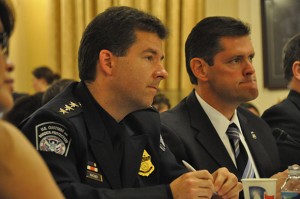
Acting Deputy Assistant Commissioner of the Customs and Border Protection John Wagner testifies at a house subcommittee hearing on overstay visas.
WASHINGTON – Biometric checks for immigrants leaving the country aimed at strengthening security will be tested by Customs and Border Patrol agents to determine their effectiveness and impact on passenger delays at airports, a top CBP official told a House subcommittee Tuesday.
An amendment included in the Senate immigration bill would implement a biometric exit plan in the 10 largest airports within at least the next two years and in 30 airports in the next six years. Currently, a biometric plan is only used for immigrants entering the country, not those exiting.
At a House maritime and border security subcommittee hearing, CBP Acting Deputy Assistant Commissioner John Wagner said his office is working with the Department of Homeland Security to understand how the biometric exit strategy would work in conjunction with passenger flow to ensure it wouldn’t cause airport backups.
“A lot of our transportation infrastructure was not set up to handle any outbound or exit type processing,” Wagner said.
He said CBP will be testing the procedure early next year to see how the biometric exit plan works with existing logistic capability.
Over a ten-year period, it can cost between $3 billion to $9 billion to maintain a biometric system. There are different modalities of biometrics – fingerprints, DNA or an iris check. The airports would use fingerprints to track departing passengers through the automated biometric identification system. Biometrics is about 99.9 percent accurate.
Combining a biometric exit plan with the biographical system already in place would strengthen U.S. security and regulate it more efficiently, according to Shonnie Lyon, acting director of the Office of Biometric Identity Management. It would also better regulate visa overstays and immigrants who have changed their status.
According to a report by the Government Accountability Office, there was a backlog of 1.6 million potential overstays from January to April 2011. Of those, about 44 percent were on a tourist visa and another 43 percent were admitted under a visa waiver program. Overstays are defined as foreign nationals legally admitted to the U.S. on a temporary basis who don’t leave on schedule. Many stay in the U.S. for economic reasons, but some can pose a homeland security threat, the GAO said.
As a result of the GAO report, DHS closed about 863,000 cases on the backlog list.
Five out of the 19 hijackers of September 11th were overstays and the friend of the Boston marathon bomber who was accused of disposing the suspect’s bag of fireworks and laptop entered the U.S. with an expired visa, witnesses noted.
